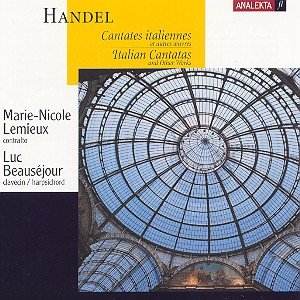Although in reality very brief, Handelís time in Italy
(1706-1710) represents one of his most productive periods. During this
tenure, Handel frequently returned to Rome, which is a mystery to many
musicologists, as he would have had no opportunity to perform or compose
opera there, the genre being banned at the time in that city. His sixty
or so Italian cantatas were written primarily for private Roman audiences.
Scholars debate as to whether or not the cantatas were a harbinger of
Handelís operatic style. Evidence toward this conclusion lies in the
composerís life-long habit of borrowing from earlier works. Much of
the material found in the cantatas turns up in later operas. On the
other hand, some cite the frequent use of chromatic melodies, contrapuntal
settings and other gestures intended to point up subtleties in the texts
as evidence of the stylistic originality of these pieces.
The keyboard suite presented here dates from 1720,
and is a response to the unauthorized publication of some of his other
harpsichord works. That the rhythmic hammering of a blacksmith inspired
the fourth movement air and variations is a legend of nineteenth century
invention. Originally attributed to Johann Sigismund Weiss (c.1690-1737),
the authenticity of the Sonata in D for flute and continuo was proven
by Handelís own self-borrowing habit. Themes from this sonata exist
in two earlier works, composed before Handel and Weiss actually met.
The air from Water Music is a transcription of Handelís own making.
The star of this excellent recital is contralto Marie-Nicole
Lemieux. Recently the winner of a number of prestigious competitions,
this singer from Quebec is starting to enjoy a wide-ranging international
career. Hers is the rich, warm contralto of the Maureen Forrester tradition,
a rare thing indeed these days. She approaches baroque music with a
full throated sound, and shies away from the "early music"
affects that clutter a great deal of current performances. She leaps
into these melodramatic texts and portrays them with intense passion,
thus granting some credibility to what could otherwise be deemed as
eighteenth century soap opera material. One is only disappointed in
her singing when she attempts coloratura. While her legato singing is
glorious, the roulades in the faster passages simply are not clean enough
to be satisfying. They sound a bit too labored and I found myself working
with her to get through them instead of marveling at their execution.
Perhaps a little less of the Forrester approach here and a bit more
of Marilyn Horneís legendary passagework would improve matters.
Luc Beauséjour is not only a fine accompanist,
but his solo playing is one of the high points of this recital. He plays
with a grace and elegance that is delightful to hear. Although his virtuosity
is apparent, he never shoves it to the foreground. Instead he lets the
music speak for itself, rollicking along with it when appropriate, singing
into it in the more lyrical moments. He shines in whatever role he is
playing on this disc. Marie-Céline Labbéís flute playing
is stylish and elegant, although I might have wanted for a little less
decay at the ends of some phrases. She produces a lovely tone. Amanda
Keesmaat is a solid continuo cellist, giving exactly what is needed
to the ensemble.
Analektaís engineers have done splendid work. I was
particularly pleased that the harpsichord was recorded in a natural
ambience, not over amplified. Face it; the harpsichord is a light delicate
instrument that was more at home in salons than concert halls. Nothing
is more annoying than hearing this instrument with a microphone shoved
down its throat. Balances are perfect and this is one enjoyable listen.
Last but not least, this is one of the best program
booklets to come across my desk in some time. The notes are excellent,
we are provided with full translations and the cover art is beautiful.
Other labels should take note: this is how it is supposed to be done!
Kevin Sutton
